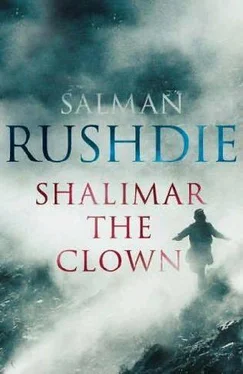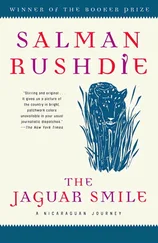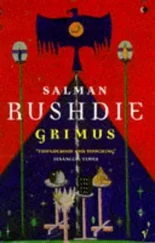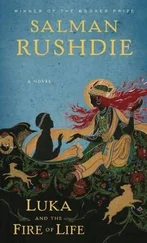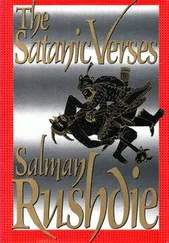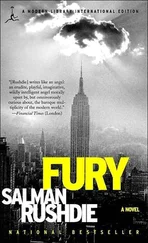When the letter avalanche began Shalimar the clown was asked first by prison officials and afterward by his attorney if he wished to see them, was warned of their tone of exceptional anger and hostility, and was firmly instructed by William Tillerman not to reply no matter how strongly he wished to do so. He insisted on being given the envelopes. “They are from my stepdaughter,” he told Tillerman, who noted that his client’s English was heavily accented but competent, “and it is my duty to read what she wishes to say. As for answering her, it is not necessary. There is no answer she wishes to hear.” The system worked slowly, and the letters were usually two or three weeks old by the time he received them, but that didn’t matter, because the moment he read the first one Shalimar the clown identified their author as the female bhoot who had been pursuing him through his terrifying nightmares. He understood at once what Boonyi’s child was telling him: that she had set herself up as his nemesis, and whatever the judgment of a Californian court might be she would be his real judge; she, and not twelve Americans in a jury box, would be his only jury; and she, not a prison executioner, would somehow carry out whatever sentence she imposed. It wasn’t important to know the how or when or where. He braced himself for her nocturnal assaults, screaming through the sedation, but enduring. He carefully read her daily indictments, read them over and over, memorizing them, giving them their due. He accepted her challenge.
After the bombing of the World Trade Center in New York-eight years later this would be remembered as the first bombing-he sat across a table from his lawyer in a stinking meeting room and expressed his fears for his safety. Even in his maximum-security, solitary-confinement wing, it was a dangerous time in prison for a Muslim man accused by the state of being a professional terrorist. Shalimar the clown dressed up for his meeting with Tillerman, as finely as prison allowed, wearing his “bonneroos,” prison-issue blue jeans and a prison-issue denim overcoat. There was a sign on the wall of the room saying HOLDING HANDS ONLY and another saying 1 KISS 1 HUG AT THE START 1 HUG 1 KISS AT THE FINISH. These messages did not apply to him. He avoided Tillerman’s eyes and spoke in a low voice in halting but serviceable English. Men died all the time in the MCJ. The sheriff blamed budget cuts but so what, that didn’t make anyone feel any safer. A convicted killer somehow managed to walk the halls at night and murder another inmate who had testified against him at his trial even though their cells had been on different floors. The other prisoners in their cells, six thousand of them, acted on gang instructions and turned their backs and saw nothing. News of such things reached Shalimar the clown even in cell block 7000. A Korean gang member was stabbed thirty times and stuffed into a laundry trolley and nobody found him for sixteen hours, until the laundry began to stink. A wife-beater had been kicked to death. Two hundred men had taken part in a race riot started by an argument about using a pay phone. In the argument one inmate was stabbed a dozen times. And now after the attack in Manhattan maybe a guard would leave a door to 7000 unlocked one night and some godzilla called Sugarpie Honeybunch or Goldilocks Ali or Big Chief Bull Moose or Virginia Slim or the Cisco Kid, some OVG-Old Valley Gangster-would wreak an American revenge. Tillerman shrugged. “Okay. I’ll take it up.” Then he leaned across the table and changed the subject. “Tell me about the girl.” Initially reluctant to reply, Shalimar the clown yielded slowly to his lawyer’s coaxing, and began to talk.
The case of the People v. Noman Sher Noman came to trial six months later at the Los Angeles County Superior Court at the San Fernando Valley Government Center in Van Nuys, before Judge Stanley Weissberg, who had been on the bench in the Simi Valley Rodney King trial, when the four LAPD officers were acquitted, precipitating the riots. He was a mild, professorial man in his middle fifties and seemed unshaken by the Simi Valley experience. Because of the heightened atmosphere created by the events in Lower Manhattan the security at the courthouse was unprecedented. Shalimar the clown arrived and left each day, shackled and chained, in a white armored van surrounded by a police operation reminiscent of a presidential motorcade. Roadblocks, motorcycle outriders, police snipers on the rooftops, an eleven-vehicle procession. “We don’t want a Jack Ruby situation here,” the city’s new chief of police, Willie Williams, told the press. What would he compare the operation to in terms of its scale, a reporter asked him. He replied with a straight face, “It’s what we’d do for Arafat.”
The court had initially summoned five hundred people for jury duty. To ensure a fair trial all five hundred had been asked to complete a hundred-page questionnaire, and on the basis of these questionnaires and the usual courtroom challenges twelve jurors and six alternates had been empaneled. Four men and eight women would try the case of Shalimar the clown. Their average age was thirty-nine. Tillerman had wanted a young jury with a female bias. He considered himself a student of human nature, and was certainly a barroom philosopher of the usual, disenchanted variety. It was his view that the young, believing themselves immortal, had less respect for human life and so were less likely to be vengeful toward a killer. And after all-this was the reasoning behind loading the jury with women-Shalimar the clown was a highly attractive man, and had a tragic tale of heartbreak and betrayal to recount. The crime of passion was not a legal category in California, in spite of which such extenuating circumstances could only help the defense.
The thirtysomething prosecutors, Janet Mientkiewicz and Larry Tanizaki, looked like baby-faced innocents next to the much older, more corpulent, worldly-wise Tillerman, but they were hardened lawyers who were determined to get their man. Tanizaki had privately expressed some doubts about the death penalty, knowing that many jurors didn’t like imposing it, but Mientkiewicz bolstered his resolve. “If this isn’t a hanging offense, nothing is,” she said on the steps of the courtroom on the day of the pretrial hearing. Tanizaki and Mientkiewicz’s greatest concern was that the defense might try to deny the crime. Strangely, even though the murder of Maximilian Ophuls had taken place on a bright, sunny L.A. day, there were no eyewitnesses. It was as if the whole street had turned its back on the event, just as the inmates of the MCJ had done on the night of the revenge killing. The prosecution had the fingerprinted knife, the bloodstained clothes, the motive, the opportunity and the evidence of Mr. Khadaffy Andang, who was cooperating fully with the state. They did not have a witness to the crime. However, William Tillerman informed them at the pretrial hearing that his client would not deny responsibility for the death of Ambassador Ophuls; but he added that if the charge were not reduced from murder in the first degree, then a not-guilty plea would have to be entered. “My client is a severely disturbed man,” he averred. What was he suffering from, Judge Weissberg wanted to know. “The effects,” Tillerman solemnly replied, “of witchcraft.”
A woman, my mother, died for the crime of leaving you, Kashmira wrote. A man, my father, died for taking her in. You murdered two human beings because of your egotism your amazing egotism that valued your honor more highly than their lives. You bathed your honor in their blood but you did not wash it clean it’s bloody now. You wanted to wipe them out but you failed, you killed nobody. Here I stand. I am my mother and my father I am Maximilian Ophuls and Boonyi Kaul. You achieved nothing. They are not dead not gone not forgotten. They live on in me.
Читать дальше
